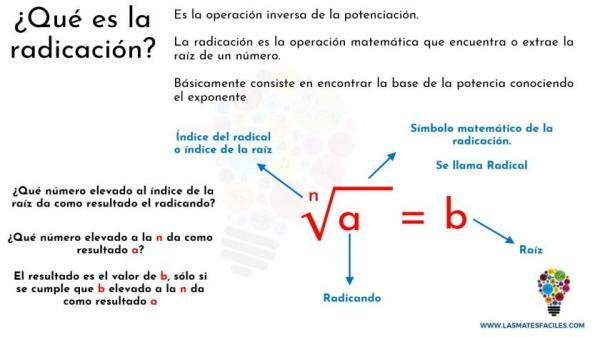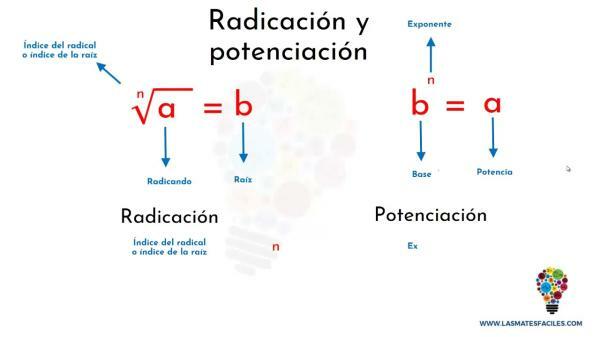What is RADICATION and its properties

In this new lesson that we bring you from a Teacher, we are going to see what is radication and its properties, always giving examples so that it is better understood. At the end of the article we will also leave you a exercise and its solution, so that you can check if you have understood what is stated in this lesson. So without further ado, let's get started!
Radication is a mathematical operation that we can classify as the opposite of empowerment. That is, to file is the opposite of raising to a whole number.
We identify the radication insofar as it is written in a characteristic way: we find the index, radicand and root.
Thus, if we have √25 = 5, the radicand is 25 and the root 5, but the index is 2.
How do we identify the index?
Well, it's very simple, if we don't have any number, the index will be 2. If it is not 2, we will have a small number written above the location symbol, such as: ∛8 = 2, in which index is 3.

Image: Easy dunks
The most common examples are those of square roots, that is, the roots of index two. However, cube roots are also quite typical, which are those that have index three. Starting with index four, they are not as common, but they are not difficult to understand.
Typical square roots:
- √1 = ± 1
- √4 = ± 2
- √9 = ± 3
- √16 = ± 4
- √25 = ± 5
- √36 = ± 6
- √49 = ± 7
- √64 = ± 8
- √81 = ± 9
- √100 = ± 10
- ...
Typical cube roots:
- ∛1 = 1
- ∛-1 = -1
- ∛8 = 2
- ∛-8 = -2
- ∛27 = 3
- ∛-27 = -3
- ...
Let's see how well you are understanding the lesson by doing the following exercises, so you can practice:
1. State whether the following sentences are true or false:
- Roots with an even index have a double result (positive and negative).
- Even-indexed roots cannot be done on a negative number.
- Roots with an odd index cannot be done on a negative number.
2. Calculate these roots step by step:
- √81
- √576
- ∛216
- ∛-2744

Image: Youtube
1.
- Roots with an even index have a double result (positive and negative).
- Even-indexed roots cannot be done on a negative number.
- Roots with an odd index cannot be done on a negative number.
2.
- √81 => 9 * 9 = 81, but also (-9) * (-9) = 81, so the answers are 9 and -9.
- √576 => 24 * 24 = 576, but also (-24) * (-24) = 576, so the answers are 24 and -24.
- ∛216 => 6 * 6 * 6 = 216, so the answer is 6.
- ∛-2744 => (-14) * (-14) * (-14) = -2744, so the answer is -14.
If you have found it a useful lesson, remember that you can share it with your classmates or continue browsing through the different lessons that we offer you.
